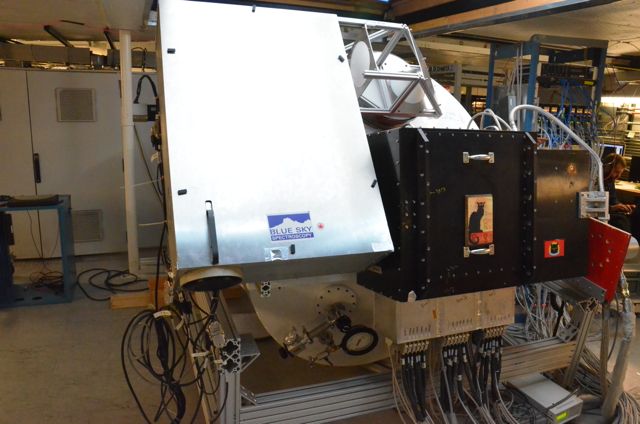Monday, January 23. 2012
Out receiver has been cold for a couple of days now, and we're starting to characterize its properties. Right now, we're using a Fourier Transform Spectrometer (FTS, http://en.wikipedia.org/wiki/Fourier_transform_spectroscopy) to measure the frequency response of the detectors. On the left, you can see the large, silver rectangle of the FTS mounted beside Black Cat on our optics cryostat. The cage on the upper right of the FTS, above Black Cat, takes the light emitted by the FTS and directs it into the cryostat window, where it can shine down on the receiver.
SPTpol has two kinds of detectors, one which is sensitive to light with frequencies near 90 GHz, and one which is sensitive to light with frequencies near 150 GHz. We chose those particular frequencies because 1) the CMB is (relatively) bright in those frequencies of light, 2) the atmosphere at the South Pole is transparent at those frequencies, and 3) the "shadow" which clusters of galaxies cast on the CMB (another kind of science that we're interested in) is most easily detectable at those frequencies. We use various filters to block out light with frequencies that we don't want to detect, and, before we start looking at the sky, we need to measure to be sure we know which light can get in, and which can't.
The FTS measurements are finishing up right now, and, when we're done, the next step will be to actually attach our brand-new receiver to the telescope. CMB, here we come!

The FTS mounted on the optics cryostat.
Trackbacks
Trackback specific URI for this entry
No Trackbacks
Calendar
|
|
July '24 | |||||
| Mon | Tue | Wed | Thu | Fri | Sat | Sun |
| 1 | 2 | 3 | 4 | 5 | 6 | 7 |
| 8 | 9 | 10 | 11 | 12 | 13 | 14 |
| 15 | 16 | 17 | 18 | 19 | 20 | 21 |
| 22 | 23 | 24 | 25 | 26 | 27 | 28 |
| 29 | 30 | 31 | ||||
Categories
Statistics
Last entry: 2014-01-28 04:43
41 entries written


